Running a successful webinar requires constant audience engagement — which is why this guide is going to walk you through 12 proven webinar engagement strategies:
Note: Our webinar platform, eWebinar, was built with pre-recorded webinars in mind but many of the engagement strategies below can be used for both live and automated webinars. If any of the strategies are exclusive to automated webinars, we'll be sure to let you know.
Let's dive in!
What is webinar engagement?
Webinar engagement occurs when those attending your online event have an interactive and engaging experience. Webinar engagement is also considered an important metric which is calculated by dividing the number of attendees who interact with you in some way (e.g. messaging in chat) by the total number of attendees in the audience.
Before the webinar
The three pre-webinar engagement strategies we'll cover are:
-
Building compelling landing pages
-
Researching audience interests
-
Creating email sequences
#1. Build attractive landing pages
Catch your audience's attention before they even sign up for your webinar by building an attractive landing page. At a minimum, there are four questions that your landing pages need to answer within just a few seconds for visitors to become registrants:
-
Is this for me?
-
Who's behind this training?
-
Can I trust what they're teaching?
-
When can I watch?
Your above-the-fold copy (i.e. the portion of your landing page that's visible without website visitors having to scroll down) should include the main topic, date/time, agenda of what will be covered, who's delivering the presentation, and a CTA button to register for the webinar.
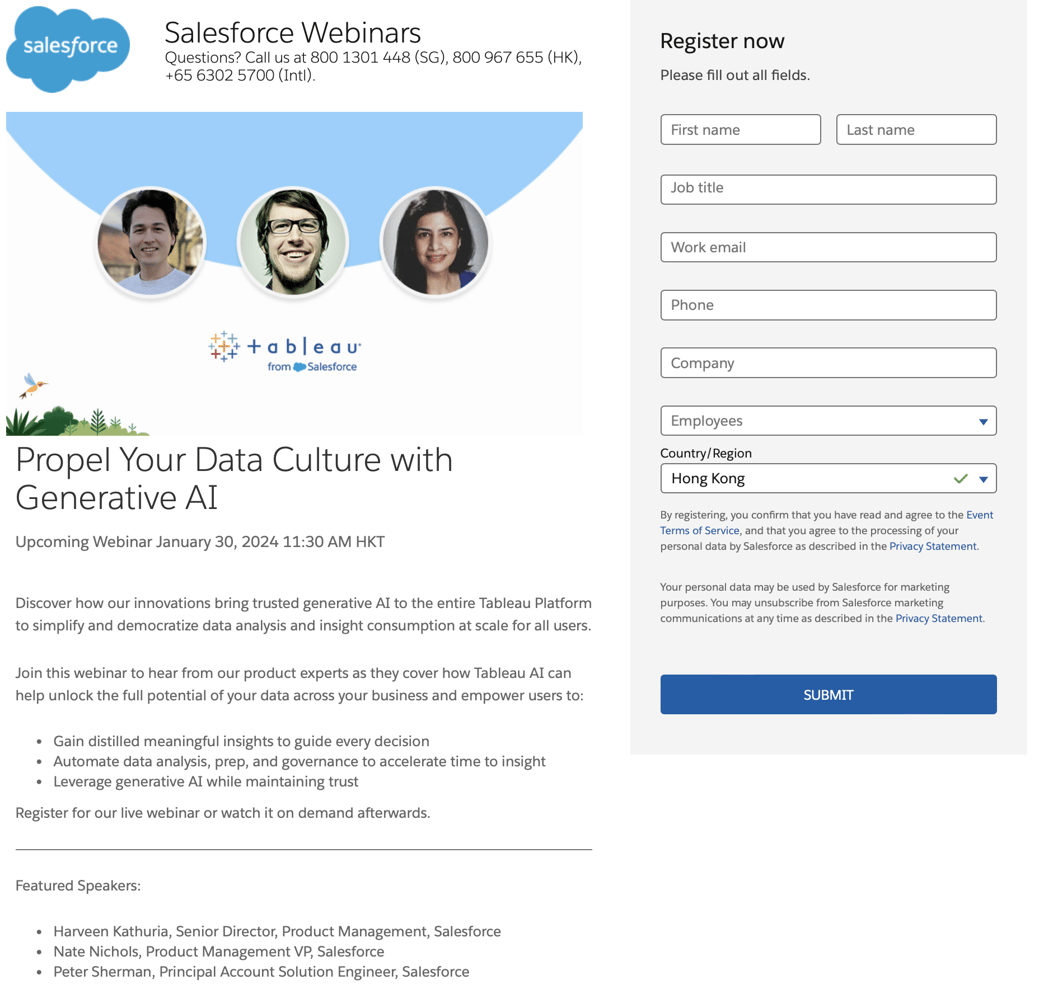
Source: Salesforce
Be sure to mention benefits that appeal to specific audience segments in your title/headline.
"How to 2x Organic Traffic With On-Page SEO [Registration Ends Soon]" is more enticing than "Get Traffic With Content Marketing (Webinar)" because it includes specific details, teases the desired outcome, and creates a sense of urgency.
If your webinar is a one-time event then you should also include the time and date of the presentation so those interested know if it fits into their schedule. You should also include a calendar invite or ICS file in the registration confirmation email so registrants can save the date.
Last but not least, make sure to include a headshot and short bio for each speaker to establish their credibility. Listing off their current role, how long they’ve been in the industry, and other qualifications that speak to their track record will reassure the audience of their expertise.
To learn more, read our full guide on How to Create a High-Converting Webinar Landing Page or see our list of 28 Webinar Landing Page Examples!
#2. Research audience interests
Hosting an engaging webinar is a lot easier when you already know what your attendees are looking to get out of the presentation. Choosing your webinar topic based on the needs of your audience will help you keep attendees engaged throughout the full presentation.
To ensure webinar marketing success, think about:
-
Which questions your might attendees have during the presentation
-
What problems they could be trying to overcome
-
How those pain points have shaped their goals
Instead of relying on assumptions alone, you can also conduct pre-webinar surveys or even 1-on-1 interviews before the webinar and audience polls during the presentation itself to gather detailed actionable insights from your engaged audiences.
#3. Create email sequences
Email sequences are the most effective way to reach your target audience before and after the webinar.
There are four types of emails that you'll need to include in your webinar sequence:
-
Webinar invitation emails. Invitation emails can be used to promote upcoming webinars to an existing audience such as those who subscribe to your newsletter.
-
Registration confirmations. Confirmation emails let registrants know that their registration was successful and give them an easy way to add the event to their calendar.
-
Registrant reminder emails. Reminder emails can increase attendance by ensuring that webinar registrants don’t forget about the event in the weeks, days, and minutes leading up to it.
-
Post-webinar follow-up emails. Follow-up emails help you gather attendee feedback, nurture your leads, and help you nudge other attendees who didn't convert during the webinar.
To learn more, read our full guide on Effective Webinar Email Sequences!
During the webinar
It's important to note that engagement tools vary by webinar platform. Some platforms only include a couple of interactions to choose from and others may fall short on their chat capabilities. The engagement strategies below assume that your platform of choice includes these must-have features.
Note: If the webinar platform you're currently using doesn't have the features that you need then consider watching our on-demand demo to see if eWebinar would be a better fit!
#4. Communicate through chat
The point of hosting webinars — instead of uploading videos or streaming webcasts — is to facilitate two-way communication and be able to answer attendees' questions in real time. The easiest way for webinar hosts to engage attendees is to respond to their chat messages.
Attendees feel engaged when hosts respond to them which encourages them to keep watching and sending more messages. This back-and-forth between hosts and attendees continues to be important whether you're hosting live webinars for thought leadership or on-demand webinars for lead generation.
Despite the fact that chat can help you build a dedicated community and drive sales, not all webinar platforms handle it very well. Many live webinar platforms don't let you answer audience questions after the presentation ends while some automated webinar platforms lack the ability to respond in real time.
This is why we set out to build our own platform with both real-time and post-webinar responses:
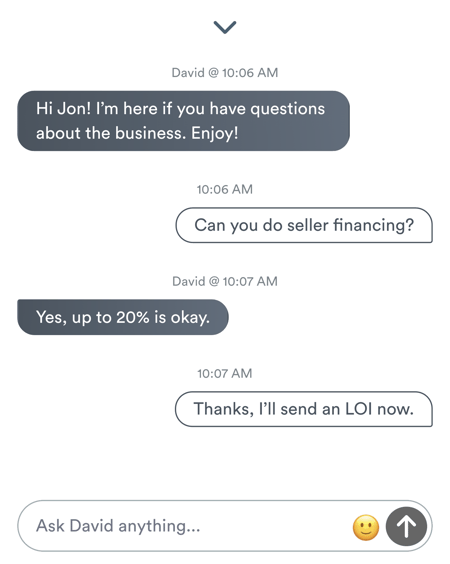
During live webinars, hosts need to be selective about which questions they choose to answer since they need to keep the presentation going and wrap up at some point. In contrast, automated webinars let you answer every question and meet each attendee’s needs.
Our webinar platform, eWebinar, has a robust chat system that's built to ensure that all chat messages receive a timely response. You (or an assigned moderator) can respond in real time through the chat, send replies from Slack with our integration, or reply after the presentation via email.
To see our chat in action, join our on-demand demo. (We use eWebinar to run it!)


#5. Incorporate interactive elements
While interactive features are bound to vary between webinar platforms, most have at least a couple that you can use to create an engaging presentation and encourage audience participation. There are a few different types of interactive elements that you can use during live webinars:
-
Polls. Letting attendees vote on polls will help you keep the audience engaged while helping you gather valuable insights. Some webinar platforms come with built-in polling features but, if the platform you use doesn't, you can use third-party applications like StrawPoll.
-
Quizzes. Quizzes can boost engagement by challenging attendees' recall skills and solidifying key information in their memory. You could even offer prizes for those who get a perfect score like free eBooks, coaching sessions, website audits, or product trials to generate leads.
-
Whiteboards. Collaborative whiteboards are another way to make the presentation more interactive and facilitate audience participation. Much like polls, you can use third-party software like Miro if your webinar platform doesn't have a whiteboard feature.
These are just a couple of examples of ways to make your live presentation more interactive for those attending it. Our webinar platform, eWebinar, has 20+ unique interactions that hosts can choose from when automating their presentation:
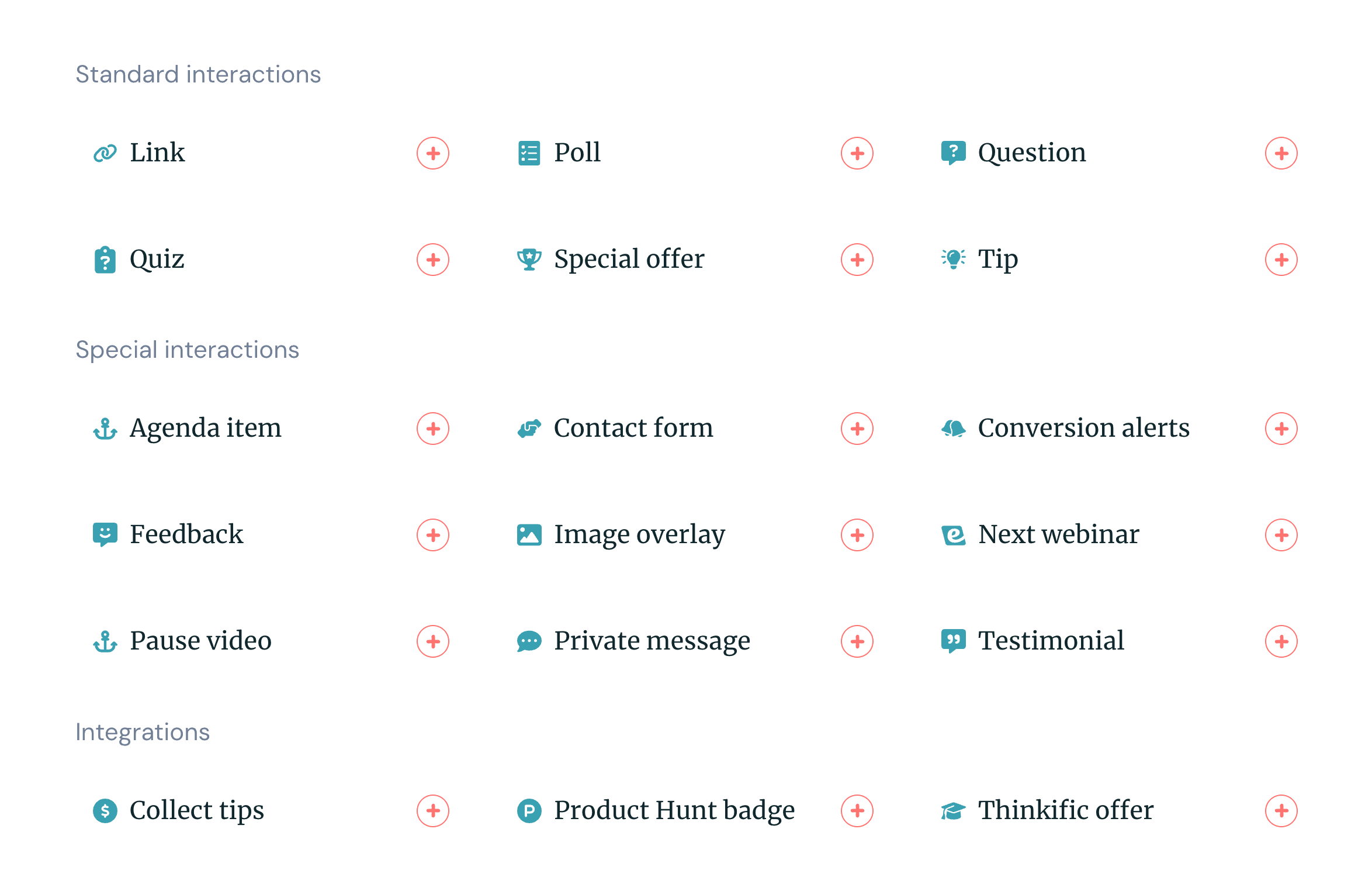
Deploying a ton of interactions might not make as much sense for live webinars because it’s hard to keep track of polls and respond to chat while giving your presentation in real time. However, those creating automated webinars have more bandwidth to make it interactive.
Because the presentation itself is pre-recorded, you’ll be able to add in as many interactions as you want without missing chat messages or getting distracted while presenting to a live audience.
To learn more, read our full article on How to Make a Webinar Interactive From Beginning to End!
Note: Did you know that automated webinars can actually be more interactive than live webinars because they allow you to plan ahead and insert interactions that make the presentation interactive all throughout? If you want to experience automated interactivity for yourself then watch our demo!
#6. Enable breakout rooms
Zoom breakout rooms were popularized by the video conferencing platform as an easy way to split a single meeting into multiple rooms with different participants and a host that could freely move between each room.

Source: Zoom
That said, the engagement potential of breakout rooms doesn't need to be limited to virtual meetings since the same feature can also be used during webinars (if the platform you're using supports it). There are two main types of breakout rooms:
-
Automatic. Some platforms automatically assign participants based on the number of breakout rooms you created which can save time if your webinar has a large audience.
-
Manual. Other software lets the host manually assign attendees to a room or ask participants which breakout room they'd like to join.
Zoom supports both types of breakout rooms but your webinar platform might only support one or even neither. Regardless of which approach you take, breakout rooms are a great way to boost engagement between attendees!
#7. Prepare a slide deck
Preparing well-designed presentation slides before the day of the webinar is worth the effort because it will make it much easier to get your point across to the audience. When spoken words and gestured hands fall short, slide decks serve as the last-mile delivery of your core message.
Here are a few best practices to follow when creating your own webinar slide deck:
-
One idea per slide. Instead of overwhelming your audience with multiple statistics, charts, graphs, and sentences within a single slide, it's best to cover one idea at a time. This will help you emphasize each point without overwhelming your attendees.
-
Center framing. Because attendees could be attending your webinar from a number of different device types and aspect ratios, it's always a good idea to put information in the center of your slide. This will ensure that nothing is cut off at the corner or cropped in a weird way.
-
QR codes. If you'll be including links within your presentation slides, add a QR code beside them that attendees can scan. Unless your webinar is doubling as a typing speed test, don't put attendees through the gauntlet of typing out links manually before the slide disappears.
-
Visuals. In comparison to in-person events with large projectors, most webinars are consumed on laptops or smartphones with smaller screens. This is why your slides should be eye-catching enough to stand out even at a miniaturized scale.
-
Icons. Icons may seem trivial but they can add a unique and engaging feel to your slide deck when used properly. Consider using relevant icons instead of standard bullet points or using emojis within sentences to get your point across in a more succinct way.
If you don't want to build a slide deck from scratch then you can use Visme's free webinar presentation templates to get a head start!
Tip: If you’re creating pre-recorded webinars then you have the unique opportunity to plan your script, slide deck, and interactive elements ahead of time. This will take a bit longer to do but leaves you with an evergreen content asset with continuous returns on your investment.
#8. Use virtual whiteboards
We already touched on whiteboards above but their benefit is two-fold since you can use them both as an instruction device and a participation magnet:
-
Host instruction. Hosts can use whiteboards to get their point across in a visual way without an overreliance on pre-existing slides. This can be especially useful for handling attendee questions that you encounter for the first time (if you're hosting webinars live).
-
Audience participation. Attendees can use whiteboards to share their thoughts in real time using collaborative software like Miro, Lucidspark, or FigJam. This is perfect for attendees who may be unsure of how to parse their questions without visual aids.
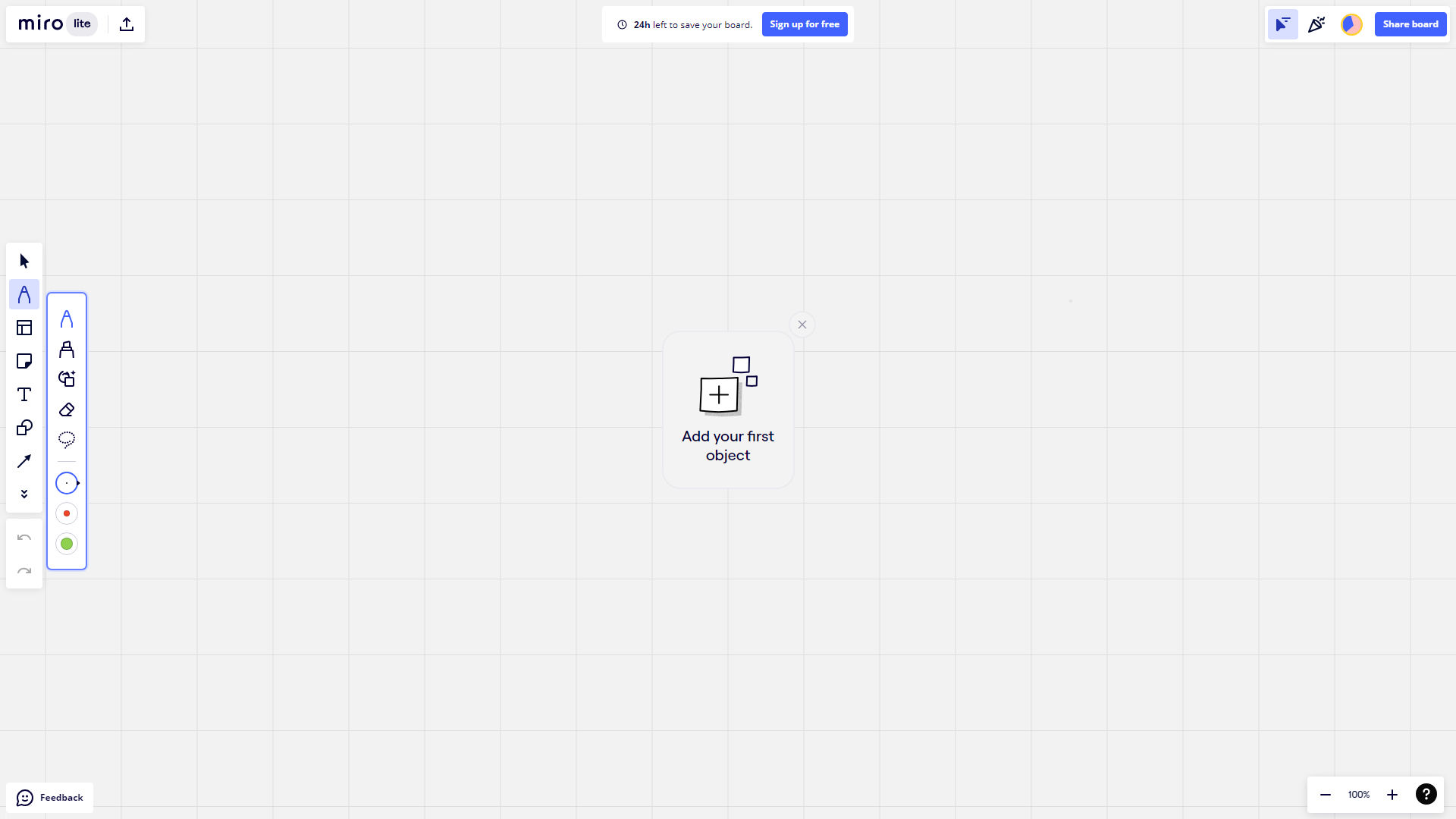
Source: Miro
In comparison to slide decks that need to be prepared ahead of time, virtual whiteboards are perfect for impromptu illustrations that can be edited on the fly. It's possible to use physical whiteboards too if you have a lapel mic, chat moderator, and a camera that can capture you clearly from a distance.
#9. Have a Q&A segment
Q&A sessions are a staple of webinar engagement activities and usually happen towards the end of the presentation.
There are a few benefits to running a Q&A segment during your webinar:
-
Attendee participation. First and foremost, answering attendee questions throughout (or at the very least after) the presentation will encourage attendee participation and keep everyone engaged longer. This goes back to the importance of live chat that we covered earlier.
-
Questions/objections. If you're hosting webinars to sell a product or service then the ability to address unanswered questions and lingering objections is crucial. This helps you convert leads who are already on the fence but reluctant to take the next step.
-
Audience feedback. Remember that attendees aren't the only ones allowed to ask questions. The host can also use this segment to ask the audience about their experience during the presentation and take suggestions on what to improve next time.
Having a public chat is ideal for live webinars because it leverages the communal interaction that makes these one-time events feel special. This also facilitates communication between attendees while the host is presenting.
The problem with Q&A segments during live webinars is that not everyone will get their question answered before the presentation ends. Others might have questions but be too intimidated to ask them publicly in front of a large audience.
In contrast, automated webinars make it easy for shy attendees to reach out to the host privately and have a 1-on-1 conversation instead of leaving messages in the public chat of a live presentation. This empowers attendees to engage with you whenever they want (whether you're in the session or not).
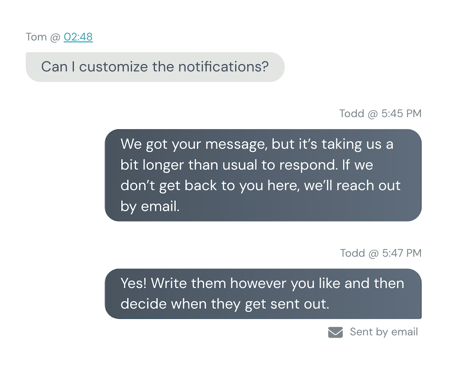
Like we mentioned earlier, those hosting webinars using eWebinar will be able to respond to attendees in real time (through the chat itself or integrated Slack channels) as well as forward responses via email after the presentation ends.
After the webinar
The job isn't done once the presentation ends since you still need to reach out to engaged webinar attendees. The final sections below will go over the last three steps that you need to execute to wrap up your post-webinar engagement strategy:
-
Collect attendee feedback
-
Share the replay link
-
Review analytics
#10. Collect attendee feedback
Don't miss out on the opportunity to collect feedback from audience members after the webinar ends. Sending out a post-webinar survey will encourage attendees to share their experiences with the host and hint at what they'd like to see in future presentations.
There are three main questions you should ask in your post-webinar survey:
-
Why is the webinar topic important to you?
-
Why did you sign up for this webinar?
-
How did you hear about the webinar?
The first question identifies the pain points that got attendees to register for the webinar, the second question gets them to elaborate on the specific goals they had going into the presentation, and the third question highlights your most effective promotion channels so you can double down.
To learn more, read our full guide on Best Webinar Survey Questions to Ask Before, During, and After!
#11. Share the replay link
Not everyone who signs up for virtual events ends up attending them live.
This happens for a number of reasons such as:
-
Loss of interest
-
Scheduling conflicts
-
Forgetting about the event
The first cause is unavoidable while the latter two can be addressed through webinar automation and reminder emails. Even so, there will still be people who don't attend despite your best efforts to make the schedule convenient and remind them about the event.
In these scenarios, it's important to inform attendees of what they missed by emailing a list of the most valuable takeaways — whether written by the host or compiled based on survey responses — from the presentation that they skipped.

Once you have their interest back, give them a replay link so they can watch the webinar on their own time. It's also a good idea to include invitations to any other post-webinar engagement activities in these follow-up emails so you can still capture the leads who didn't attend the event itself.
You can read our full guide on Webinar Replays to learn more about their benefits!
#12. Review analytics
To improve future events and host webinars that are better with each repetition, it's important that you review the analytics your webinar platform makes available to you. This data can yield valuable insights into how engaging your webinar content was and what you could do better next time.
A few core metrics you should keep your eye on include:
-
Registration rate
-
Attendance rate
-
Average watch time
-
Engagement rate
-
Conversion rate
The breadth and depth of analytics available to you will depend on which webinar platform you're using. To give you an idea of which metrics and dashboards to look at, we'll show you a couple of examples from eWebinar's analytics capabilities!
First off, we have an engagement heatmap that shows you the exact point in the presentation when most attendees stopped sending chat messages, leaving likes, responding to interactions, or started leaving the webinar altogether:
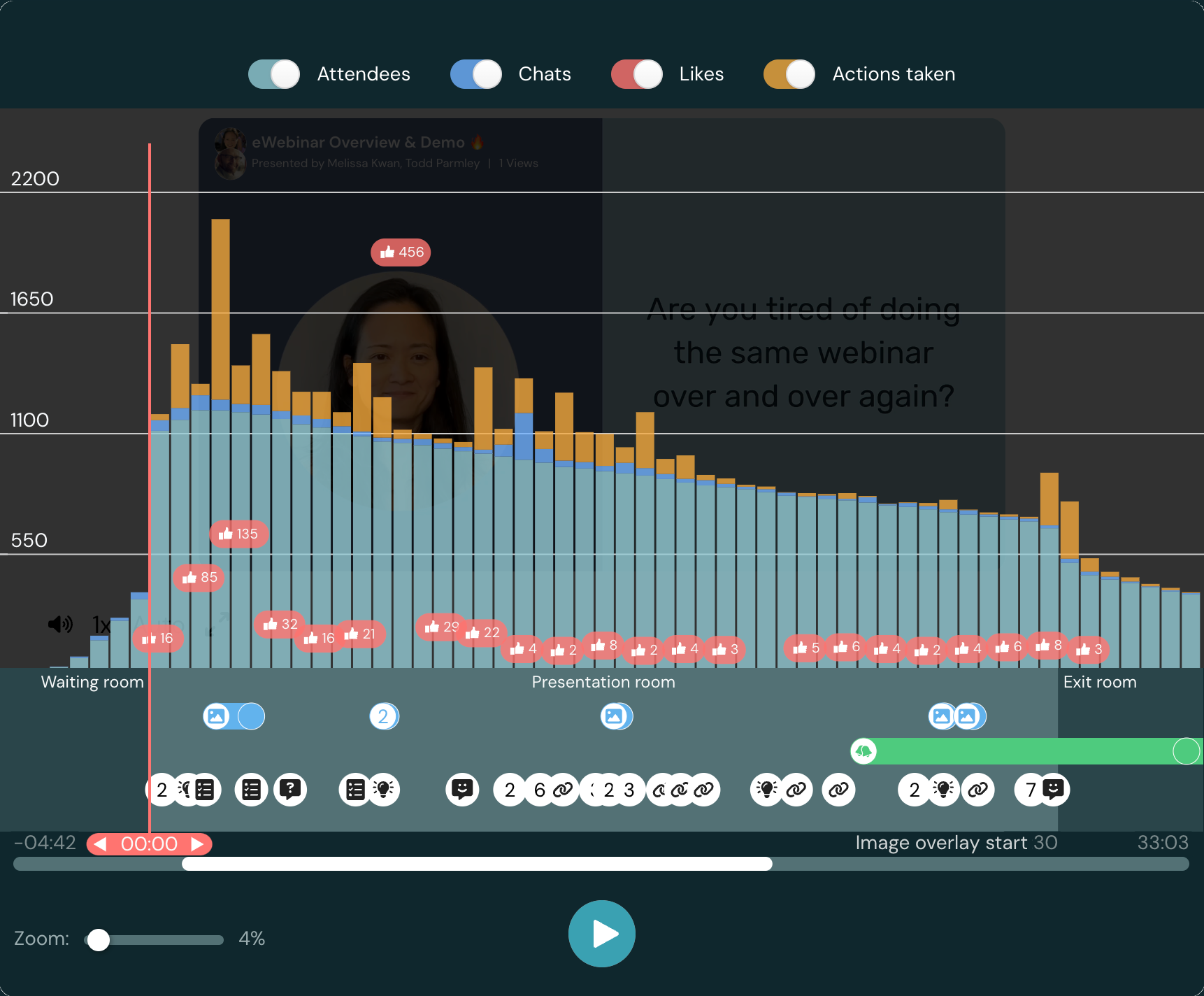
This shows you the least engaging moments of your presentation so you can liven them up next time!
If you're running webinar programs to generate leads and drive conversions then you can also look at conversion funnels to measure performance. eWebinar's conversion funnel chart shows you the number of visitors/registrants/attendees/conversions, drop-off rates between each step, and total revenue:
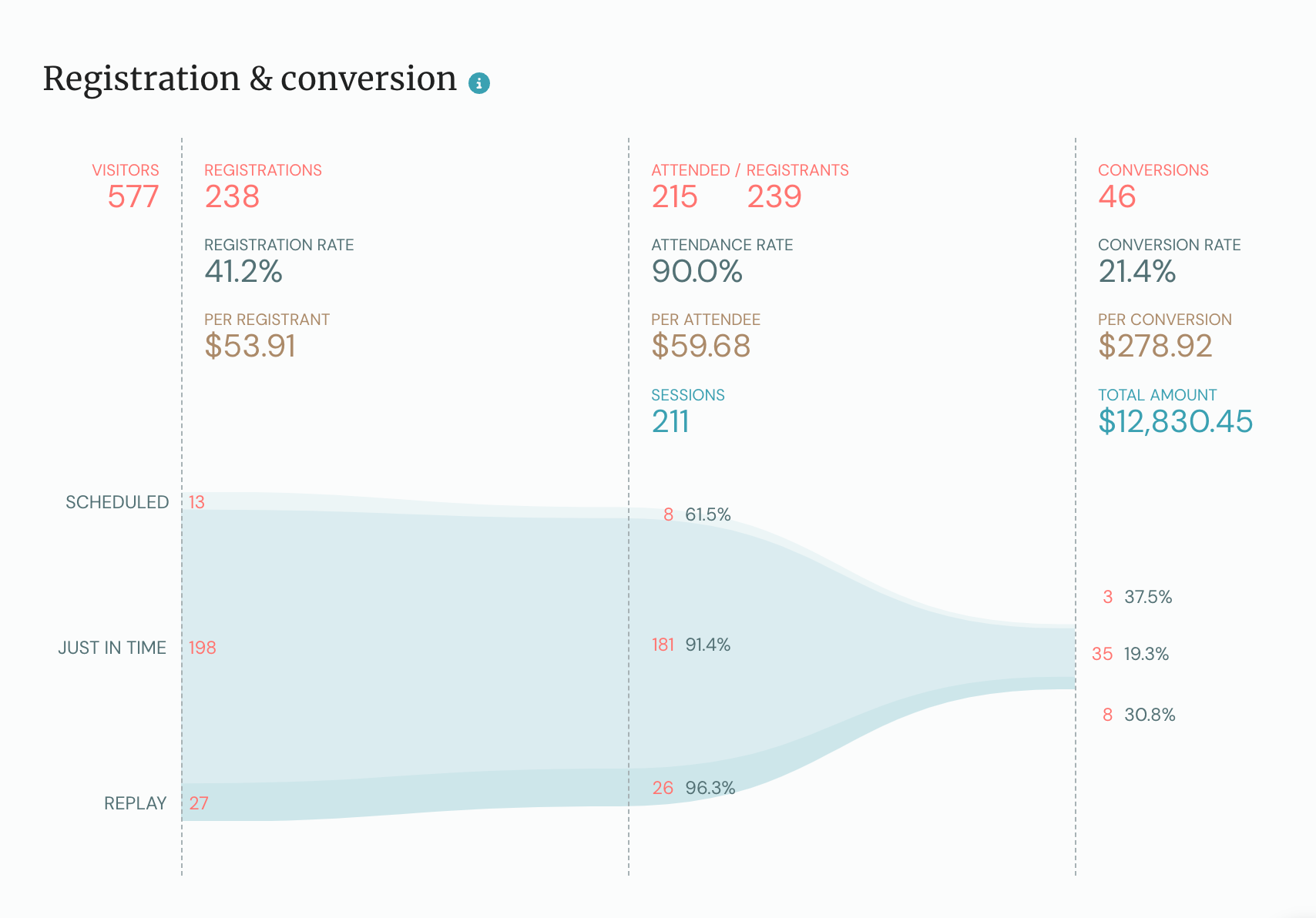
To learn more, read our full guide on Webinar Analytics!
Conclusion
This webinar engagement strategy guide is meant to be an actionable playbook that helps you increase engagement, give your attendees a better experience, and ensure that all the time spent on your presentation pays off in the end.
At the highest level, webinar strategy is about understanding the reasons that make webinar engagement matter and applying those principles using the features available to you on your platform of choice.
If your webinar platform doesn't have the audience engagement, interaction, and participation features you need then watch our demo to see if eWebinar would be a better fit for you!


FAQs
How do I make my webinar more engaging?
You can make your webinar more engaging by supporting live chat, adding interactive elements, and supporting audience participation through whiteboards, polls, or Q&A segments.
How do you engage an audience after a webinar?
You can engage an audience after a webinar through automated email sequences, post-webinar surveys, and third-party integrations that save lead information to your database.
How can you increase webinar attendance?
You can increase attendance to your webinars by sending reminder emails to those who have registered, cross-promoting to the audience of each speaker, posting on social media channels, and scheduling it at the best time/day to reach as many attendees as possible.








